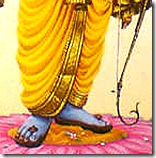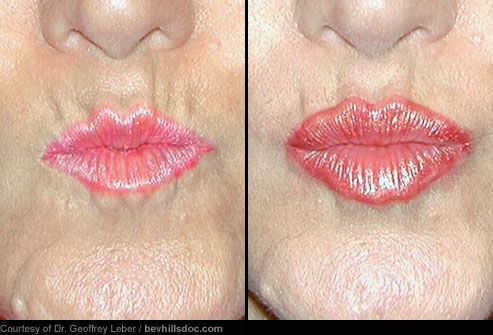 “Touching
His lotus-like hand, blessing Him on the head, and happily bringing the
Lord towards his heart, the muni felt like he was taking a dip in an
ocean of love and unable to cross over to the other side.” (Janaki
Mangala, 19)
“Touching
His lotus-like hand, blessing Him on the head, and happily bringing the
Lord towards his heart, the muni felt like he was taking a dip in an
ocean of love and unable to cross over to the other side.” (Janaki
Mangala, 19)
parasi kamala kara sīsa haraṣi hiyam̐ lāvahiṃ |
prema payodhi magana muni na pāvahiṃ ||
The
lotus flower is the symbol of purity. It remains in the clean water,
sprouts open upon the sight of the splendorous sun and then closes back
up at nighttime, as if to indicate that the absence of light is the time
to rest, to gather oneself before the next day arrives. The swans float
amidst the lotus flowers, while the crows hang around rubbish. This
dichotomy has been referenced by those with knowledge of the Absolute
Truth since time immemorial. The above referenced verse, which describes
the lotus-like hands of the hero of the Raghu dynasty, whose contact
was so heartwarming to those who are above such passionate feelings that
it created an ocean of nectar that one could not cross over, gives yet
another example of the comparison to the wonderful lotus.

An
expert swimmer can cross over a body of water, as often that is the
intended purpose when getting into the water. You prepare yourself for
the swim, keeping in mind where you want to go and how to pace yourself
so that you don’t get tired. Sometimes, though, the water is meant for
relaxation and not swimming. In the winter months, one of the worst
feelings comes from getting up in the morning to get ready for school or
work and then seeing someone else still enjoying the warmth of their
blanket. The outside environment is cold, while underneath the covers is
warm and inviting. “Why should I get up? Can’t I just stay like this
the whole day?”
For a sage a long time ago, the ocean of
transcendental nectar created through a simple and innocent embrace
flooded him with comforting emotions, a transcendental type of drowning.
This muni was residing in the pristine surroundings of the forest,
where there were minimal distractions. What kind of work did he have
that required being shut off from society? Not to be mistaken with a
hermit who hates the world or a hobbit who shuns everything around him
out of spite, the sages seeking refuge in the wilderness did so to
advance spiritually, for that is the main objective of human life.
The first tool necessary for working towards that goal is
tapasya,
or austerity. This shouldn’t be that difficult to understand, as
control and regulation are required for success in practically every
endeavor. The human being especially should pay attention to
tapasya
because they have the intelligence to understand its effectiveness. The
lower animal species don’t know anything about dieting, controlling
appetites, regulating behavior, or achieving a higher end through a
regulated set of activities intelligently crafted. The concept of
“animal instincts” is used as a reference tool for a reason. The animal
just follows its hunches and does whatever it feels like doing.
The
human being has the ability to think rationally, to develop scientific
experiments with relation to behavior. For instance, if I follow a
particular routine day after day - which can involve waking up at the
same time and eating the same foods spread out across the same intervals
- should any change occur to that routine, I can note down the results
as part of an experiment. “What if I wake up half an hour earlier
tomorrow? I’ll do everything else the same, so let me see what effect
that has on my energy levels.” A simple thing like shifting the time of
waking up in the morning can be used to find a better condition,
adjusting the routine so that the worker can perform at optimal levels.
In the Vedic tradition, much of the guesswork has been removed.
Tapasya is a trusted system whose effectiveness is rooted in the control of the senses. A
gosvami is considered a master of the senses, so they are eligible for making disciples and spreading the glories of bhakti-yoga, or
devotional service,
to a wider audience. A master is one who can turn something on and off
at any time. I may say that I am in control of my senses, but if I have
vices like drinking and smoking that I can’t control, my senses actually
own me instead of the other way around.
The senses can be owned through
tapasya,
which is practiced for meeting the highest goal of realizing God. There
is no other purpose to the human form of body. Intelligence exists for a
reason. Through intelligence a person can reach their desired end more
quickly. A desired end brings a desired result, which is bitter or sweet
depending on the intended taste. For the thief intelligence is the
ability to successfully take someone else’s property without them
knowing. For a politician intelligence is the ability to win an election
despite having governed poorly. A wise product engineer can develop a
product to the specifications of the company, so as to appeal to a mass
market of consumers and successfully carry out the desired functions.

Consciousness
is absent in matter, so intelligence used to fulfill goals that deal
with interaction with matter are all on the same inferior level. It
looks like there is variety in taste, but in the end the same rewards
are available to the animals who don’t have nearly the same intelligence
as the human beings. Real intelligence uses information and knowledge
to achieve the highest end of association with God. That goal was
fulfilled for Vishvamitra, who had previously used his knowledge of the
Vedas and belief in the words of the
acharyas to follow
tapasya under the proper guidelines.
Since the forests were conducive to austerity, they were known as
tapo-vanas.
There was one slight problem for Vishvamitra though. The forest was
free of distractions such as material allurements, but there was a
purposeful distraction surfacing. More than just a distraction, this was
a dangerous element which threatened the muni’s existence. We’re
talking about the forest here, so perhaps the allusion is to lions?
Bears? Tigers? No. Even these ferocious animals left Vishvamitra and the
other brahmanas alone.
The sages weren’t doing anything to
anyone. Their aim was to have as little material interaction as
possible. Sobriety and a renewed commitment to sacrifice, or
yajna, follow
tapasya.
A brahmana can be an expert at performing formal sacrifices, which are
meant to please Yajneshvara, which is another name for God. In the Vedas
the Supreme Lord has thousands of identified names which each remind
the infinitesimally small spiritual sparks occupying different bodies in
the material world of the Lord’s position with respect to their own
standing. For example, the living being is the controller of the actions
of their body. Since they are rulers in a sense, they are known as
ishvara.
If I know that I am a controller, one way to teach me about God is to
describe Him as being the Supreme Controller, or Parameshvara.
The
yajna
is a central practice of followers of the Vedas, and just to let the
worshipers know the real position of the person being honored, the real
enjoyer of sacrifice, God is given the name Yajneshvara, or the lord of
sacrifice. The
yajna is very powerful when carried out in the
proper mood. Through God’s satisfaction, the living being’s
consciousness becomes purified and he is better equipped to cope with
life and also teach others how to make advancement in spiritual life.
The latter aspect is what bothered a specific set of bandits, who had
the opposite intent. The thief is so immersed in their sinful ways that
they take their own values to be virtuous. This tendency also introduces
one of the defects in a system of democracy. Democracy prevents a
single leader from going off the deep end and tyrannically ruling over
the innocent people, but it also establishes relative morality. You and I
may know that stealing someone else’s property is wrong, but should a
majority vote in Congress say otherwise, the practice suddenly becomes
virtuous.
The ghoulish creatures concentrated on the island of
Lanka during Vishvamitra’s time decided that their acts of killing
innocent creatures and eating them were pious. So infested by sinful
behavior was their city that no amount of wine, women, or animal flesh
was enough to satisfy the appetite. The Rakshasas in Lanka would
regularly harass the sages of the
tapo-vanas, disrupting their sacrifices. They would wear false guises and then pounce on the unsuspecting munis just as their
yajnas were about to bear fruit.
Vishvamitra
approached the king of Ayodhya, Maharaja Dasharatha, for protection in
this area. Dasharatha had four young sons, the eldest of whom was the
Supreme Lord appearing in a seemingly human form. Upon first meeting
Dasharatha, Vishvamitra was greeted by the boys, and he was especially
enchanted by the eldest Rama. In the above referenced verse, the muni is
embracing the children after they offered him their respects.
“How
can that female swan who is accustomed to sporting with the king of
swans amidst lotus flowers ever cast her eyes on a water-crow that stays
amidst bunches of grass?” (Sita Devi speaking to Ravana, Valmiki Ramayana, Aranya Kand, 56.20)

Rama’s
hand is likened to a lotus flower, a comparison made quite often in
Vedic literature. The Supreme Lord’s features are all pure, so the lotus
flower is one of the best representations of His purity.
Sita Devi,
Rama’s future wife, would one day compare being with Rama to living
amidst lotus flowers. She would also compare the Rakshasas to crows who
hung around garbage all the time. The lotus flower is beautiful and its
association inviting.
Vishvamitra received young Rama’s hand,
embraced the Lord to his chest, and then felt so much happiness that he
lost himself. This meeting was the real fruit of his
yajna, the reward for his
tapasya. This proves without a doubt the purpose behind austerity, the reason to observe fasting days and keep the senses in check.
Gosvamis
master their senses for a reason. If I starve the senses of things that
are harmful, when something beautiful does come along, it is
appreciated all the more.

Vishvamitra
appreciated Rama’s presence and delighted in the Lord’s association, as
any person should do. The holy name is our way to embrace God today,
for simply by
chanting, “
Hare Krishna Hare Krishna, Krishna Krishna, Hare Hare, Hare Rama Hare Rama, Rama Rama, Hare Hare”,
the sweet association of the jewel of the Raghu dynasty, who has
lotus-like hands and eyes, can be enjoyed. To relish that taste, to
really understand how the holy name and the person it addresses are one
and the same, austerity in the form of abstention from
illicit sex,
gambling,
intoxication and meat eating is required.
How
did Vishvamitra get out of that ocean? Lost in a sea of happiness, did
he give up his dedication to piety, to teaching others about spiritual
life? Eventually he was able to break out of the trance, but he used the
opportunity of his visit to ask for Rama’s protection in the forest.
Through his request, Dasharatha would be troubled, but the world would
be granted the gift of the image of Rama and His younger brother
Lakshmana
honorably escorting a worshipable muni through the forests and
protecting him from the vile creatures given towards rooting out piety
from society. Dasharatha granted the favor to Vishvamitra, and the sage
favored countless future generations by desiring to be in Rama’s
association. If we should be so lucky to stay around the lotus-like
Lord Rama we too will swim in an ocean of transcendental nectar.
In Closing:
Not in an endless sea of sorrow did he drown,
Rather pool of joy’s nectar through Rama found.
Comparisons help us God to understand,
Thus like a lotus flower was Shri Rama’s hand.
Reward for austerity in the forest,
Muni brought lovable prince to his chest.
Royal order to provide protection meant,
Thus Rama and Lakshmana with muni king sent.
That delight of Raghu dynasty incarnates through name,
So chant it regularly to acquire highest gain.
 “Touching
His lotus-like hand, blessing Him on the head, and happily bringing the
Lord towards his heart, the muni felt like he was taking a dip in an
ocean of love and unable to cross over to the other side.” (Janaki
Mangala, 19)
“Touching
His lotus-like hand, blessing Him on the head, and happily bringing the
Lord towards his heart, the muni felt like he was taking a dip in an
ocean of love and unable to cross over to the other side.” (Janaki
Mangala, 19) An
expert swimmer can cross over a body of water, as often that is the
intended purpose when getting into the water. You prepare yourself for
the swim, keeping in mind where you want to go and how to pace yourself
so that you don’t get tired. Sometimes, though, the water is meant for
relaxation and not swimming. In the winter months, one of the worst
feelings comes from getting up in the morning to get ready for school or
work and then seeing someone else still enjoying the warmth of their
blanket. The outside environment is cold, while underneath the covers is
warm and inviting. “Why should I get up? Can’t I just stay like this
the whole day?”
An
expert swimmer can cross over a body of water, as often that is the
intended purpose when getting into the water. You prepare yourself for
the swim, keeping in mind where you want to go and how to pace yourself
so that you don’t get tired. Sometimes, though, the water is meant for
relaxation and not swimming. In the winter months, one of the worst
feelings comes from getting up in the morning to get ready for school or
work and then seeing someone else still enjoying the warmth of their
blanket. The outside environment is cold, while underneath the covers is
warm and inviting. “Why should I get up? Can’t I just stay like this
the whole day?” Consciousness
is absent in matter, so intelligence used to fulfill goals that deal
with interaction with matter are all on the same inferior level. It
looks like there is variety in taste, but in the end the same rewards
are available to the animals who don’t have nearly the same intelligence
as the human beings. Real intelligence uses information and knowledge
to achieve the highest end of association with God. That goal was
fulfilled for Vishvamitra, who had previously used his knowledge of the
Vedas and belief in the words of the acharyas to follow tapasya under the proper guidelines.
Consciousness
is absent in matter, so intelligence used to fulfill goals that deal
with interaction with matter are all on the same inferior level. It
looks like there is variety in taste, but in the end the same rewards
are available to the animals who don’t have nearly the same intelligence
as the human beings. Real intelligence uses information and knowledge
to achieve the highest end of association with God. That goal was
fulfilled for Vishvamitra, who had previously used his knowledge of the
Vedas and belief in the words of the acharyas to follow tapasya under the proper guidelines. Rama’s
hand is likened to a lotus flower, a comparison made quite often in
Vedic literature. The Supreme Lord’s features are all pure, so the lotus
flower is one of the best representations of His purity.
Rama’s
hand is likened to a lotus flower, a comparison made quite often in
Vedic literature. The Supreme Lord’s features are all pure, so the lotus
flower is one of the best representations of His purity.  Vishvamitra
appreciated Rama’s presence and delighted in the Lord’s association, as
any person should do. The holy name is our way to embrace God today,
for simply by
Vishvamitra
appreciated Rama’s presence and delighted in the Lord’s association, as
any person should do. The holy name is our way to embrace God today,
for simply by 



